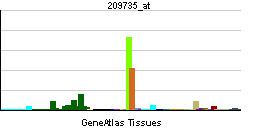Entrez 9429 | Ensembl ENSG00000118777 | |
 | ||
Aliases ABCG2, ATP-binding cassette, sub-family G (WHITE), member 2 (Junior blood group), ABC15, ABCP, BCRP, BCRP1, BMDP, CD338, CDw338, EST157481, GOUT1, MRX, MXR, MXR1, UAQTL1, MXR-1, ATP binding cassette subfamily G member 2 (Junior blood group) External IDs MGI: 1347061 HomoloGene: 55852 GeneCards: ABCG2 | ||
ATP-binding cassette sub-family G member 2 is a protein that in humans is encoded by the ABCG2 gene. ABCG2 has also been designated as CDw338 (cluster of differentiation w338).
Function
The membrane-associated protein encoded by this gene is included in the superfamily of ATP-binding cassette (ABC) transporters. ABC proteins transport various molecules across extra- and intra-cellular membranes. ABC genes are divided into seven distinct subfamilies (ABC1, MDR/TAP, MRP, ALD, OABP, GCN20, White). This protein is a member of the White subfamily. Alternatively referred to as the Breast Cancer Resistance Protein, this protein functions as a xenobiotic transporter which may play a role in multi-drug resistance to chemotherapeutic agents including mitoxantrone and camptothecin analogues. Early observations of significant ABCG2-mediated resistance to anthracyclines were subsequently attributed mutations encountered in vitro but not in nature or the clinic. Significant expression of this protein has been observed in the placenta, and it has been shown to have a role in protecting the fetus from xenobiotics in the maternal circulation.
The transporter has also been shown to play protective roles in blocking absorption at the apical membrane of the intestine, and at the blood-testis barrier, the blood–brain barrier, and the membranes of hematopoietic progenitor and other stem cells. At the apical membranes of the liver and kidney, it enhances excretion of xenobiotics. In the lactating mammary gland, it has a role on excreting vitamins such as riboflavin and biotin into milk.
